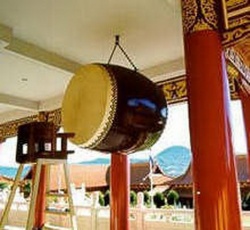Morning Gong and Evening Drum
When you first hear about "the morning gong and evening drum", this phrase may be mistaken as: "the gong is sounded in the morning and the drum is hit in the evening." In Buddhism, the correct way to explain is: "In the morning, the gong is sounded first then the drum is hit; in the evening, the drum is hit first and then the gong is sounded."
Both the gong and the drum are one of the most important Dharma instruments to the temple. In Buddha's time, the gong and drum were used to gather everyone to announce the precepts, meal times, Dharma talks etc. Up until now, they have become equipments to announce the times to wake up and go to bed.
Inside the temple, the building in which we find the drum is the "drum storey". In most temples, the drum and gong are usually placed on the two sides of the main shrine, therefore the name "the left drum and the right gong" has been created.
The drum is hit steadily in a combination of fast and slow paces creating a roaring sound of poundering thunder. If your listen very carefully you will be able to recognise sounds of the wind, rain, and thunder; these sounds signify timely wind and rain (good weather) and national prosperity.
In the morning, the gong is set to create a stream of intense sounds followed by a slow pace. This is to remind the mass that they are have come to the end of a long night and do not indulge oneself in deep unconsciousness; in the evening, the gong is sounded in the reverse order, that is, slow then a faster pace, this is to remind everyone that they should be aware of illusions and unconsciousness; also that they must help relieve all beings in the nether world from suffering. The gongs in Chinese Temples are sounded one hundred and eight times each time, because sentient beings have one hundred and eight types of worries. Therefore, the gong is used to evoke the one hundred and eight "Samadhi's" in everyone and to eradicate the one hundred and eight karmas. According to the Vinaya words: " Upon hearing sounds of the gong, worries will be ceased, wisdom will grow, Bodhi will be born, from hell that one will go, vows will be created to become a Buddha, and to save all sentient beings." Therefore the reason that temples sound the gong every morning and evening is very significant; also the daily routines of a temple starts and ends with the sounding of the gong.
As the stories have told, two nations, the "Indo-Seythians" and "Parthia" were involved in a battle. The Indo-Seythians killed nine billion soldiers of the enemy and became the victorious ones. However, because of the killing, their king suffered from the severe karmic effect. After he died, he was reborn as a fish with a thousand heads with wheels of sharp swords surrounding its body, cutting itself continuously. Each time a head has been cut off, a new one will grow back in place, the pain was indescribable. One day, the fish met a Buddhist Monk from a temple near the sea, so it begged the Buddhist Monk:
"Small portions of the pain from this agony of the cycle of transmigration are released every time I hear the sound of your gong, therefore can the compassionate master please sound the gong often for my sake." After that, the Buddhist Monks exhibited great compassion for the sentient beings, hoping to relieve them from the sea of suffering; they sounded the gong continuously. This tradition has lived up until today, some temples still sounded the gong continuously through out the day, and this is called "Gong of the nether world".
In today's society, many suffer from stress that occur within our lives and spiritual lives that are drying up. When they hear sounds of the gong from temples occasionally, they will be able to get away from all worries and bathe in the environment of tranquillity and peace away from this mundane world.
Fo Guang Shan Nan Tien Temple abides by the Monastery traditions to sound the gong every morning at 6:00 and afternoon at 4:30. This is carried out continuously through out each day. With a solemn, sincere and greatly compassionate heart, the morning gong and evening drum is sounded.
